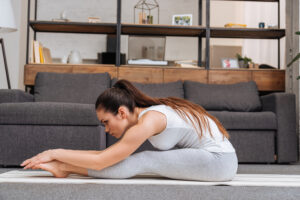
Paschimottanasana is a sitting forward bend that helps to release tension in the shoulders, hamstrings, and back. It also calms the nervous system and the mind. This mild stretch revives and energizes every cell of the body. Paschimottanasana tones the abdominal organs, increases flexibility, and enhances digestion.
Before trying Paschimottanasana, seek advice from a medical expert or a yoga instructor if you have any underlying health concerns or injuries like back injury, pregnancy, and high blood pressure.
Table of Contents
TogglePreparation for Paschimottanasana
Preparing and warming up the body before attempting this pose is essential. A mild warm-up helps lengthen the spine and release tension. Some warm-up preparatory stretches for the Paschimottanasana pose are:
Cat-Cow
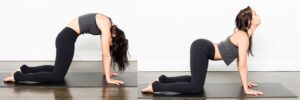
- Starting on all fours, place your hands under your shoulders and your knees under your hips to perform the cat-cow stretch.
- Breathe in as you drop your belly, arch your back, and raise your head (Cow Pose).
- Breathe while bending your back and bringing your chin to your chest (Cat Pose).
Standing Forward Bend
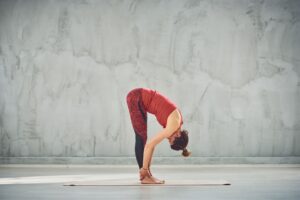
- Stand on the mat with the spine lengthened
- Inhale. Raise your arms,
- Exhale, contract your belly and bend forward from the hips.
- Flatten your palms on the mat or hold onto your ankles.
- When you inhale, extend your back, and as you release the breath, go deeper into the position.
Downward-Facing Dog
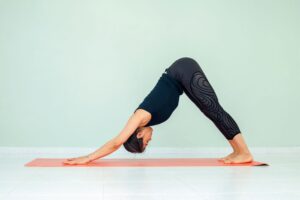
- Come on all fours, place your hands under your shoulders and your knees under your hips.
- Raise your hips and straighten the legs, tuck your toes beneath, and push back through the hands.
- Spread the fingers on the mat for support.
- Move your shoulder blades from the ears toward your hips.
- Sink your heels toward the floor, rotate the thighs inward, and maintain a high tail.
- The space between the hands and feet should be the same.
Bound angle pose
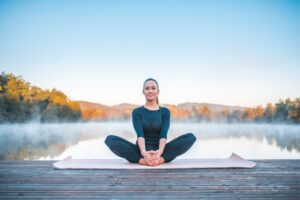
- Come to a seated position. Pull your feet’ soles together, letting your knees fall to the sides.
- Hold onto the outsides of the feet. Bend slightly forward from the hips and lengthen the spine.
- Now, flap the thighs like the wings of the butterfly.
- Perform the stretch for 30 seconds.
How to do Paschimottanasana
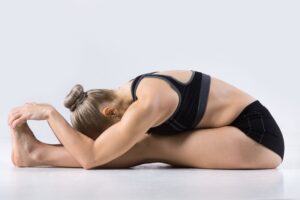
- Sit in the Dandasana pose.
- Contract the belly inward and gently press your sitting bones into the floor.
- Inhale and extend your back
- Exhale and bend forward from the hips.
- Maintain a straight back and avoid overstretching.
- Hold your big toes if your hands reach your feet as you glide across.
- Keep your elbows bent, extending them outward, and keep your shoulders away from your ears.
- To extend the position further, raise your head slightly and lengthen across the front of your chest with each inhale.
- Try to fold farther into the posture with each exhale.
- Release the feet gradually, and take a breath to exit the posture.
- As you release, slowly take a seat upright.
Variations and Modifications of Paschimottanasana
Caterpillar Pose
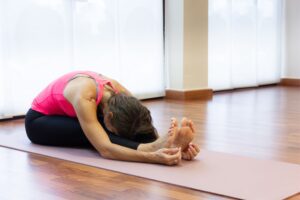
- Sit with your legs straight in front.
- Lean forward, letting the back curve.
- Place your hands on the ground or your toes, ankles, or shins.
- Relax the legs and hold the pose for 30 seconds.
Head-To-Knee Pose
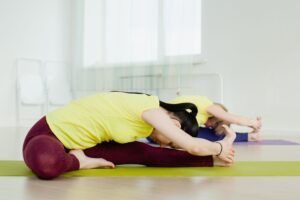
- Extend your legs in front of you in Dandasana
- Bend the right knee and press the right foot on your left inner thigh.
- Inhale, lengthen the spine and lift your arms.
- Exhale, bend forward from the hips and rotate your upper body slightly to face the left leg.
- Hold for 5-10 deep breaths. Repeat with the other leg.
Seated Forward Bend Pose Strap
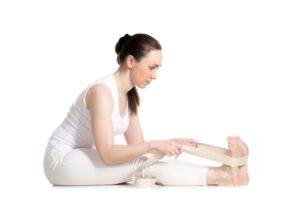
- Sit in the Dandasana pose.
- Sit upright. Use extra blankets below your seat if you feel sitting in this posture is difficult.
- Elevate the torso by pressing your thighs into the ground. Bring your spine and ribs forward to the front body.
- Put a belt around the feet and grip each side with both hands.
- Pull yourself forward slowly while maintaining a long spine until you feel a stretch at the back of your legs.
- Lift the chest as you pull the belt.
- Hold for 5-10 deep breaths.
Seated Forward Bend Pose A
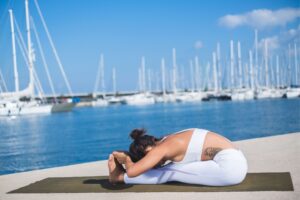
As you perform the Paschimottanasana, hold the big toes as you stretch forward.
Seated Forward Bend Pose B
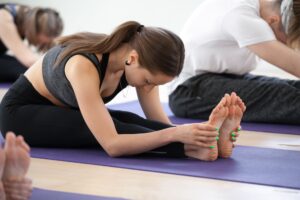
Hold the soles of the feet in this variation as you stretch forward.
Seated Forward Bend Pose C
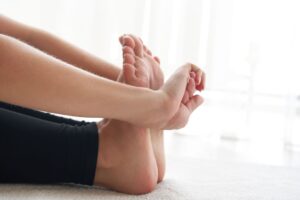
This variation requires you to wrap your hands around the soles of the feet and grab the wrist. This promotes a deeper stretch.
Seated Forward Bend Pose with a Blanket
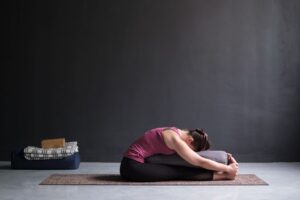
Individuals with large bellies may find it challenging to perform Paschimottanasana. The blanket and bolster on their legs give their tummy room to breathe naturally. The leg bolster also helps to maintain a straight alignment and aids in knee joint toning.
Finding time for calm and relaxation in our hectic environment is essential to our general well-being. Know that growth requires time, so appreciate the little victories you make along the journey to flexibility.
Common Misalignments during
Paschimottanasana
It is essential to align yourself correctly to prevent strain or injury. Here are some beginner-level tips on how to improve Paschimottanasana and prevent common misalignments.
Props: To gradually progress into the pose and maintain good posture, one may use a bolster, blanket, or yoga blocks initially for support. If one cannot support the feet, grasp a strap with both hands and wrap it around the feet’s soles. Maintain a straight arm.
Rounding the back: Rounding the back is one of the most frequent misalignments in Paschimottanasana. This may put undue strain on the spine and reduce the pose’s benefits. Instead, when you fold forward, concentrate on keeping the spine long. Extend your chest toward your toes instead of down near your thighs to maintain a straight back.
Overstretching: It’s crucial to refrain from pushing the body into a deep bend. Excessive exertion may result in strain or damage. Instead, let the body open up bit by bit over time. Look for a stretch instead of strain.
Shoulder and neck tension: When performing Paschimottanasana, many individuals tend to hold tension in the neck and shoulder region. You can ease yourself into this posture by releasing the weight of your upper body onto a bolster or two cushions in the lap.
Physical Benefits of Paschimottanasana
The seated forward bend has several physical advantages. The benefits of Paschimottanasana are as follows:
Increased Flexibility
The calves, hamstrings, and spine are mainly stretched during the practice of Paschimottanasana. Frequent practice helps an individual gradually become more flexible and opens up new ranges of motion, which helps deepen the forward fold.
Relieves Back Pain
A sedentary lifestyle and extended sitting can cause lower back tension and pain. Paschimottanasna extends the ligaments of the back muscles and fosters correct body alignment.
Improved Digestion
Paschimottanasana is one of the best yoga poses for digestion. It engages the abdominal organs and stimulates the liver, kidneys, and pancreas. These organs are gently compressed and massaged to facilitate better digestion, relieve constipation, and support digestive health in general.
Mental Benefits of Paschimottanasana
The Paschimottanasana benefits an individual from an emotional and mental standpoint as well. It calms the neural system. Paschimottanasana stimulates the parasympathetic nervous system. This fosters a sense of peace and tranquility while reducing stress, anxiety, and exhaustion. The forward fold helps to promote mindfulness and cultivate inner peace
- Vibhuti Pada – Yoga Sutras of Patanjali Chapter 3 - May 24, 2024
- Sadhana Pada – Yoga Sutras of Patanjali Chapter 2 - April 20, 2024
- Samadhi Pada: The First Chapter Of Patanjali Yoga Sutras - April 18, 2024
